Are you curious about what is abhyanga massage? Abhyanga massage is an ancient Ayurvedic technique that has been used for centuries to promote health and well-being. It is a full-body massage that uses long, rhythmic strokes to stimulate circulation and lymphatic drainage, while nourishing the skin and calming the nervous system. This comprehensive guide will provide an overview of abhyanga massage, its benefits, and how to incorporate it into your self-care routine.
Contents
Definition of Abhyanga Massage
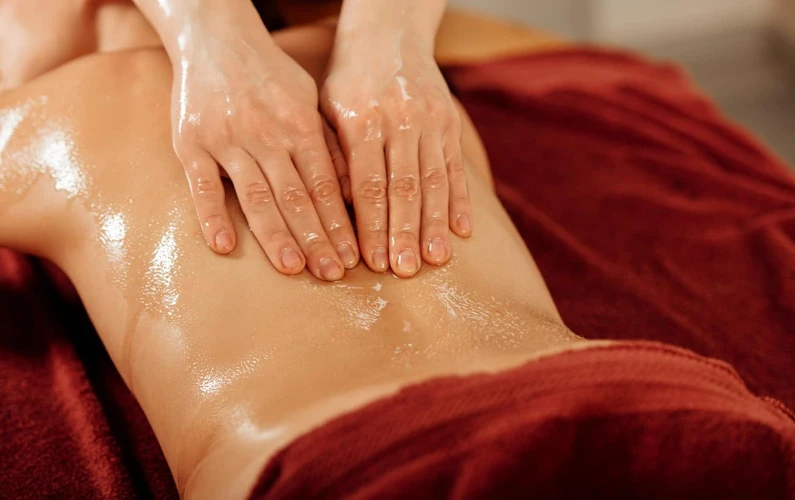
Abhyanga massage is an ancient Ayurvedic technique that involves the use of herbal oils and rhythmic strokes to massage the entire body. This massage is believed to bring balance to the body, mind, and spirit. Abhyanga massage is also known as the ‘oil massage’ and is thought to help improve circulation, improve the skin’s texture, and promote relaxation. Abhyanga massage is usually done in a series of four to six sessions. It is said to be beneficial for people of all ages and health levels. The massage is typically done in a warm, comfortable environment with a gentle, soothing touch. It is important to note that what is considered an Abhyanga full body massage will vary depending on the practitioner, as the technique can be tailored to each individual.
History of Abhyanga Massage
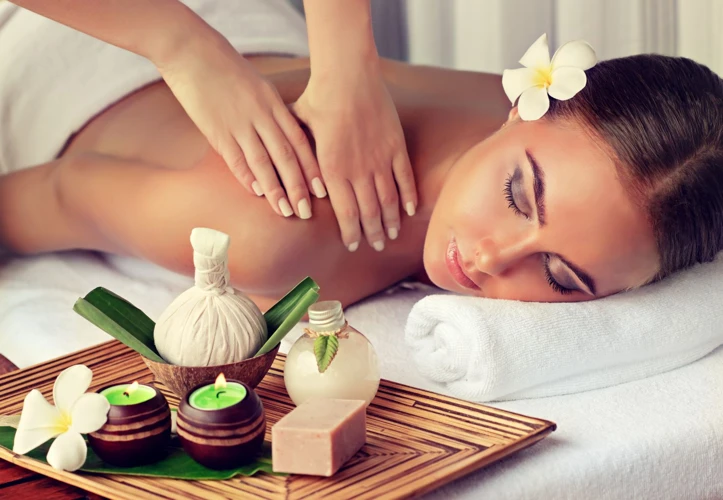
Abhyanga massage is an ancient Ayurvedic technique that has been practiced for thousands of years. It is believed to have originated in India, in the Vedic period (1500-500 BCE). The technique was mentioned in the ancient medical texts of Charaka Samhita and Sushruta Samhita, and in the Vedas.
Abhyanga massage is a type of massage that involves the use of warm oil to stimulate the body’s natural healing processes. The massage helps to improve circulation and lymphatic drainage, relax the muscles, reduce stress, and improve overall health and wellbeing.
The technique was traditionally used to treat a wide range of health issues, such as joint and muscle pain, headaches, digestive problems, and fatigue. It is also believed to be beneficial for mental and emotional wellbeing.
Today, Abhyanga massage is still widely used in India and other parts of the world, including the United States. It is believed to be one of the most effective Ayurvedic therapies, and is highly recommended for anyone looking to improve their overall health and wellbeing.
Benefits of Abhyanga Massage
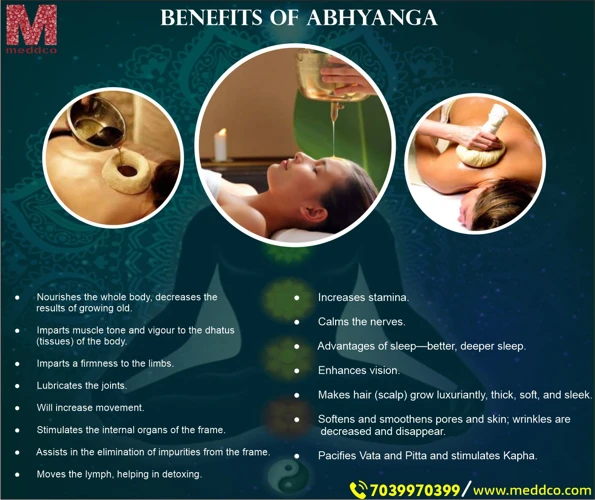
| Benefit | Description |
|---|---|
| Improves Circulation | Abhyanga massage helps to improve the circulation of blood and lymph in the body, providing essential nutrients to all the cells and organs, and removing waste products. |
| Nourishes the Skin | Abhyanga massage helps to nourish the skin, leaving it soft and supple. Natural oils used in the massage are quickly absorbed and penetrate deeply into the skin, improving its texture and appearance. |
| Relieves Stress | Abhyanga massage is a form of Ayurvedic self-care that helps to relax and calm the body, relieving tension and stress. The gentle and rhythmic strokes help to reduce cortisol levels and promote feelings of peace and harmony. |
| Promotes Sleep | Abhyanga massage helps to reduce insomnia and improve the quality of sleep. The gentle and soothing massage helps to relax the body and mind, allowing for restful sleep. |
| Reduces Pain | The gentle strokes of an Abhyanga massage can help to reduce muscular pain, stiffness and tension in the body. Natural oils used in the massage help to lubricate the joints, providing relief from pain and discomfort. |
| Increases Immunity | Abhyanga massage helps to strengthen the immune system by stimulating the lymphatic system and improving circulation. This helps to remove toxins from the body and increases resistance to disease. |
Abhyanga massage is a great way to relax, reduce stress and improve overall wellbeing. Practicing Abhyanga massage regularly is a simple and effective way to stay healthy and can be done easily from the comfort of your own home.
Principles of Abhyanga Massage
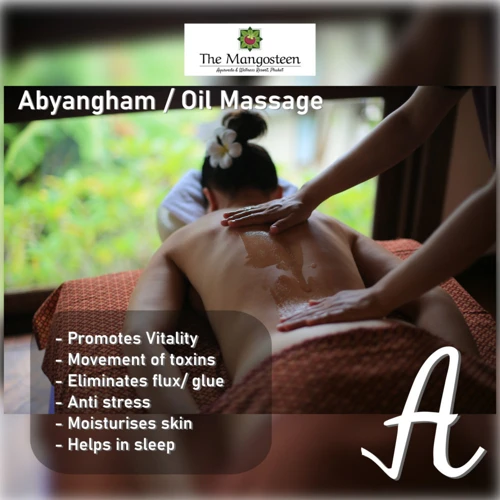
| Principle | Explanation |
|---|---|
| Tapping | Abhyanga massage incorporates the tapping technique, which involves tapping on the body with the hands and fingers to help relax tense muscles and improve circulation. |
| Stroking | The therapist performs a gentle, long-stroke massage to help stimulate the circulation of blood and lymphatic fluids and to promote relaxation. |
| Circular Massage | The therapist uses their palms and fingertips to perform circular massage movements over the entire body, focusing on the areas that are tense or sore. |
| Kneading | The therapist uses their knuckles to knead the muscle tissue and help to work out knots and tension. |
| Friction | The therapist uses their fingertips to apply firm pressure to the muscle tissue, helping to relieve tightness and improve circulation. |
Abhyanga massage also incorporates the use of medicated oils, which helps to nourish and moisturize the skin, as well as to reduce inflammation and improve circulation. The therapist applies the oil to the body with their hands and works it into the skin using the techniques mentioned above. The massage is finished off with a gentle steam to help further relax the body.
Types of Abhyanga Massage
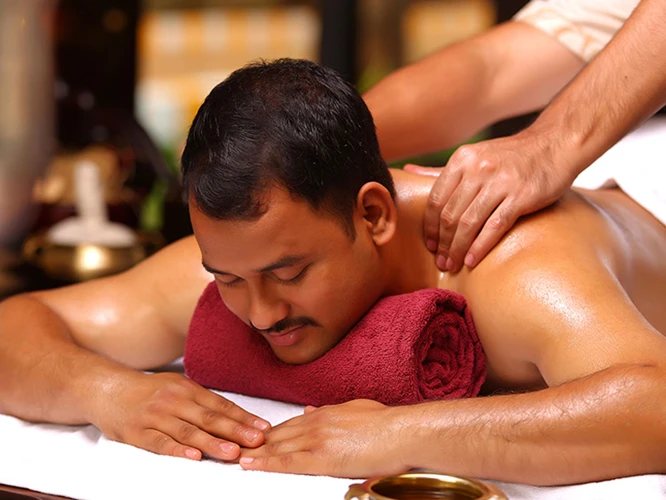
- Udvartana: This type of Abhyanga massage uses herbal powders to massage the body. It is believed to be beneficial in reducing excess fat, improving skin tone, and detoxifying the body.
- Ksheera Abhyanga: This massage uses milk to hydrate and nourish the skin. It is believed to be beneficial in reducing wrinkles and revitalizing the skin.
- Garshana Abhyanga: This type of massage uses a silk glove to exfoliate the skin. It is believed to be beneficial in removing dead skin cells, increasing circulation, and stimulating cell regeneration.
- Sarvanga Abhyanga: This massage uses warm oil and herbs to massage the entire body. It is believed to be beneficial in relieving stress, improving circulation, and promoting relaxation.
- Kati Abhyanga: This massage uses warm oil and herbal pastes to massage the back and neck. It is believed to be beneficial in relieving tension, improving posture, and reducing pain.
How to Prepare for an Abhyanga Massage
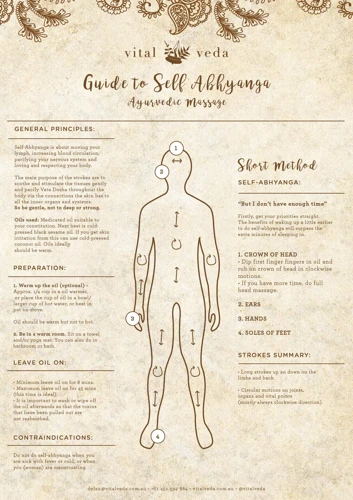
- Choose the Right Oil: Abhyanga massage is typically performed with warm oil, such as sesame or coconut, so it is important to select the right oil for your skin type. Consult your therapist or an Ayurvedic practitioner for the best oil for your body type.
- Take a Warm Shower: Taking a warm shower before the massage helps to open the pores and make the skin more receptive to the oil.
- Set a Relaxed Atmosphere: Setting a relaxed environment is essential for an effective Abhyanga massage. To do this, turn off your phone and any other distractions, light some candles or incense, and play some calming music.
- Wear Loose, Comfortable Clothing: You will be asked to remove your clothing for the massage, so it is important to wear something that is comfortable and easy to take off.
- Clear Your Mind: Spend a few moments before your massage to clear your mind and clear any negative thoughts that may be on your mind.
What to Expect During an Abhyanga Massage
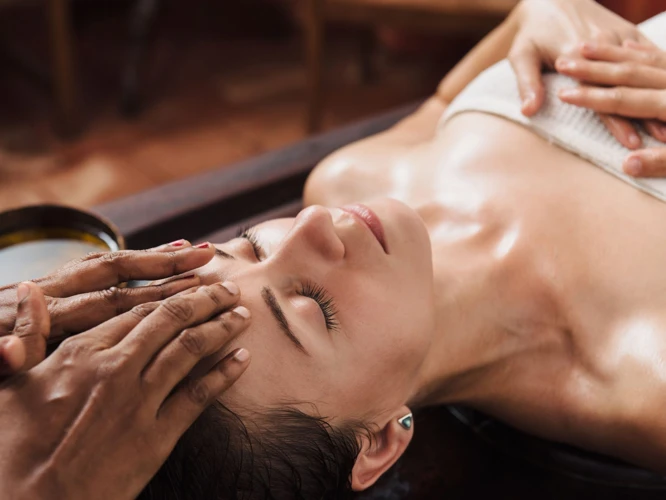
- Oil Application: Abhyanga massage is done with herbal oils. The oil used depends on your Ayurvedic dosha and is chosen to balance your constitution. The oil is then applied to your body in a rhythmic manner, using long strokes.
- Marma Stimulation: The massage also includes stimulating the marmas – the vital points within the body where energy channels flow. This helps to open up blocked energy channels and allow for a deeper flow of energy throughout the body.
- Ayurvedic Herbal Powder Massage: An Ayurvedic herbal powder massage may also be included as part of the Abhyanga massage. This powder is chosen to suit your individual needs and helps to soothe the body and mind.
- Shirodhara: Shirodhara is a part of Abhyanga massage where warm oil is poured over the forehead in a continuous stream. This helps to induce a deep state of relaxation and helps to balance the energy of the body and mind.
- Warm Towel Treatment: After the Abhyanga massage, warm towels are used to remove the oil from the body. This helps to relax the body and mind and allows for a deeper connection with the healing process.
How to Do Abhyanga Massage at Home
Abhyanga massage can easily be done at home with minimal supplies and the right technique. To begin, you will need an appropriate massage oil. Depending on your dosha type, you can choose from sesame, almond, or coconut oil. Warm the oil before beginning the massage. Start with your legs, and work your way up. Massage in circular motions, and focus on areas that feel particularly tight.
Once you have finished with the legs, move onto the arms and torso, using the same circular motions. Again, focus on any areas that feel particularly tight or tender. After the arms and torso, move onto the head. Using your fingertips, massage the scalp in gentle, circular motions.
Once you have finished with the massage, it is important to let the oil sit on the body for 15-20 minutes. This will allow the oil to penetrate the skin and work its magic. After this time, you can take a warm shower to rinse off the oil.
Abhyanga massage is an incredibly powerful tool that can be used to promote both physical and mental wellbeing. With the right technique, you can easily enjoy this ancient Ayurvedic practice in the comfort of your own home.
Frequently Asked Questions
What are the Benefits of an Abhyanga Massage?
- Relieves Stress: Abhyanga massage is renowned for its ability to reduce stress and tension in the body. It can help to relax the mind and body and make you feel more balanced.
- Improves Circulation: Abhyanga massage helps to improve circulation in the body, increasing the flow of oxygen and nutrients to the cells. This can help to reduce fatigue and boost overall energy levels.
- Detoxifies the Body: Abhyanga massage helps to detoxify the body by stimulating the lymphatic system. This can help to flush out toxins and waste materials from the body, strengthening the immune system.
- Reduces Pain: Abhyanga massage can be used to relieve muscular aches and pains. It can help to reduce inflammation and improve flexibility, making it an excellent option for those with chronic pain.
- Improves Sleep: Abhyanga massage is known to improve sleep quality. Its ability to reduce stress and tension can help to relax the mind and body, allowing for a more restful sleep.
- Improves Skin Health: Abhyanga massage can help to improve the health of the skin. It can help to reduce wrinkles, blemishes and dryness, leaving your skin looking and feeling smoother and softer.
Is Abhyanga Massage Suitable for Everyone?
Abhyanga massage is suitable for everyone, regardless of age or gender. It is beneficial for people with a variety of health conditions such as high or low blood pressure, arthritis, headaches, chronic fatigue, and depression. It is also beneficial for those who are simply looking for a relaxing massage experience. It can be tailored to your needs and can be adapted to be gentle or more intense.
How Often Should One Get an Abhyanga Massage?
The frequency of Abhyanga massages depends on the individual’s lifestyle, health, and body type. Generally, it is recommended to receive an Abhyanga massage at least once a week. People with specific health issues, such as chronic pain, may choose to receive a massage more frequently. It is important to consult a certified Ayurvedic practitioner to determine the best frequency for your individual needs.
Are There Any Contraindications to Abhyanga Massage?
Abhyanga massage is generally considered safe for most people, but there are certain conditions that may cause it to be contraindicated. These include:
- Pregnancy: Abhyanga massage is not recommended during the first trimester of pregnancy, due to the risk of miscarriage.
- Skin disorders: Abhyanga massage may worsen certain skin disorders, such as eczema or psoriasis, so it is best to seek advice from a medical professional before proceeding.
- Open wounds: Abhyanga massage should not be performed on any open wounds or areas of broken skin.
- Heart conditions: Abhyanga massage should be avoided by people with certain heart conditions, such as congestive heart failure or high blood pressure.
- High fever: Abhyanga massage should not be performed if the patient has a high fever.
- Infections: Abhyanga massage should not be performed if the patient has an active infection.
It is important to consult with a qualified healthcare professional before undergoing Abhyanga massage, to ensure it is safe for you.
What Oils Are Typically Used for Abhyanga Massage?
A variety of oils are used for Abhyanga massage, chosen depending on the individual’s dosha (Ayurvedic body type). These oils are typically warm, fragrant and rich in medicinal properties.
Sesame Oil – This oil is light and penetrating, and is recommended for people with a Vata dosha. It is said to nourish the skin and help reduce stress.
Coconut Oil – This oil is cooling and lubricating, and is recommended for people with a Pitta dosha. It is said to nourish the skin and cool the body.
Mustard Oil – This oil is warming and stimulating, and is recommended for people with a Kapha dosha. It is said to help reduce stagnation and promote circulation.
Almond Oil – This oil is light and nourishing, and is recommended for all three doshas. It is said to help nourish the skin and promote relaxation.
Other oils may also be used for Abhyanga massage, such as sunflower oil, jojoba oil, and ghee. Depending on the individual’s needs and preferences, a variety of combinations may be used.
Conclusion
Abhyanga massage is an ancient Ayurvedic technique that involves massaging the body with warm oil. It offers numerous benefits, including improved circulation, increased flexibility, improved sleep, and reduced stress and anxiety. This massage technique is suitable for everyone and can be adapted to meet individual needs and preferences. You can benefit from abhyanga massage whether you choose to get it done professionally or do it on your own.

